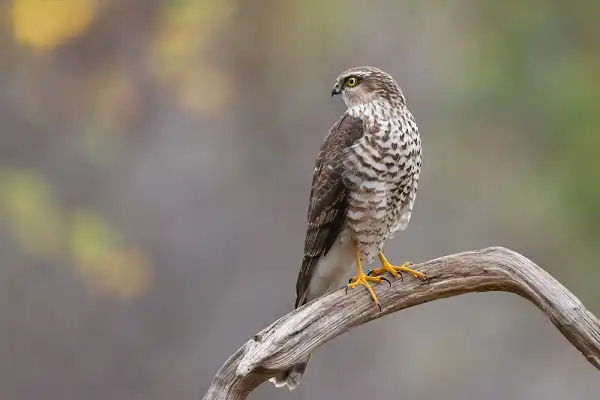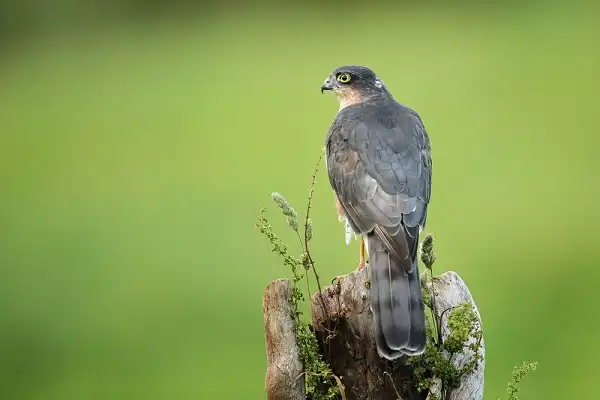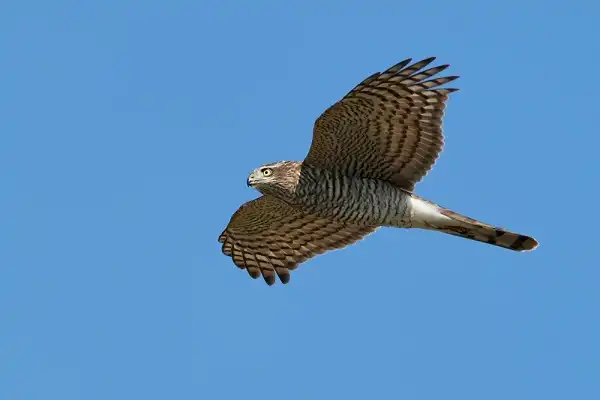The sparrowhawk, a graceful and well-known bird of prey, is an impressive hunter that has become increasingly visible in urban environments. Exhibiting agility, speed, and stunning beauty as they fly through the trees or soar across open skies – the sparrowhawk is truly a sight to behold! Not only fascinating to watch but their presence provides an important ecological service – they help to keep rodent populations down by preying on mice and other small mammals. Read on to learn more about this incredible raptor’s behavior, habitat preferences, and conservation status.

Sparrowhawk Description
The sparrowhawk, scientifically known as Accipiter nisus, is a small bird of prey belonging to the Accipitridae family. This species is sexually dimorphic, with the male being smaller than the female, and displaying distinctive blue-grey plumage on its back and wings, contrasting with a rusty-red breast and a finely barred tail. On the other hand, the female has dark brown upper parts and greyish-brown underparts with darker bars. The sparrowhawk’s plumage is a beautiful combination of browns, oranges, and whites, with darker markings on their wings and tail feathers. Adult males have a distinctive blue-grey head, while females have a brown head with streaks of white. Juvenile birds have a more muted coloring and take on adult plumage gradually over the course of their first year.
Sparrowhawk Habitat
The sparrowhawk is a bird of prey that can be found in a wide range of habitats, including forests, woodlands, and urban areas. Although they prefer to nest in tall trees, they have adapted well to living near humans and can be seen hunting in parks and gardens. Interestingly, sparrows are known to have a strong connection to their preferred habitat. They are particularly sensitive to changes in their environment and will often move to a new location if the area becomes unsuitable. This can be due to factors such as habitat loss, pollution, or changes in climate. Therefore, it is vital to preserve and protect their natural habitats. In Europe, the sparrowhawk can be found in almost every country. They are particularly common in the United Kingdom and are one of the most frequent birds of prey seen in urban environments. In Asia, they are found in the temperate forests of Japan, Russia, and China. In Africa, they are known to inhabit the woodlands of North Africa.
Sparrowhawk Diet
The sparrowhawk is a bird of prey that relies on its acute eyesight to locate and capture its food. Its diet primarily consists of small birds such as finches, tits, and sparrows, as well as small mammals like mice and voles. They are skilled hunters and often catch their prey in mid-air, using their sharp talons to grasp and kill their target. Sparrowhawks are efficient predators and have been known to kill up to 10 birds in a single day, depending on the availability of prey in their environment. Their hunting strategy involves stealth and speed, and they will often surprise their prey with a sudden burst of acceleration. Interestingly, the sparrowhawk’s diet varies depending on its age and sex. Juvenile sparrowhawks have a generalist diet and will often target small passerines such as sparrows and finches. Adult females, on the other hand, tend to hunt larger prey such as thrushes and pigeons, while adult males have been observed preying on smaller birds and bats.

Sparrowhawk Size
The sparrowhawk is a medium-sized bird of prey, with adult females growing up to 38 cm in length and weighing around 200 grams, while adult males are slightly smaller, measuring around 30 cm in length and weighing approximately 130 grams. The sparrowhawk has a distinctive shape, with a compact body and long, slender wings which enable it to fly swiftly and maneuver with precision through dense woodland and narrow spaces. Their wingspan ranges from 55 to 65 cm, making them capable of the quick and agile movement in their search for prey. One of the most striking features of the sparrowhawk is its sharp talons, which are used to catch and kill its prey. They have strong, curved claws that enable them to grip their prey with great force, swiftly bringing it to the ground for consumption. Interestingly, the size and weight of sparrows vary depending on their location. Sparrowhawks that inhabit colder regions tend to be larger, with a heavier body mass to better protect them from the cold. In contrast, those living in warmer areas have a smaller body size, as a lighter body mass helps them to better regulate their body temperature in hot climates.
Sparrowhawk Lifespan
The lifespan of a sparrowhawk can vary depending on various factors such as environmental conditions, availability of prey, and breeding success. On average, a sparrowhawk can live up to 10 years in the wild, but some have been known to live up to 20 years in captivity. The survival rate of juvenile sparrows is relatively low, with only around 30% surviving their first year of life. Those that do survive have a higher chance of survival in subsequent years. Adult sparrowhawks generally have a higher survival rate, with around 70% surviving from one year to the next. Other factors that can affect the sparrowhawk’s lifespan include disease, predation, and human activity. Disease outbreaks such as avian influenza and West Nile virus can significantly reduce the sparrowhawk population. Predation by larger birds of prey such as goshawks and eagles can also occur, particularly in areas of high competition for resources.
Sparrowhawk Behavior
Sparrowhawks are known for their incredibly fast and agile hunting techniques. It’s not just their hunting skills that are impressive, though. Sparrowhawks are also incredibly intelligent birds. They are known to use a variety of tactics to catch their prey, including ambushes, surprise attacks, and even distracting their prey with decoy movements. They are also able to adapt their hunting techniques to match the specific behaviors of their prey, making them even more effective predators. While they are predominantly solitary creatures, sparrows will occasionally hunt and roost in small groups. This behavior is particularly common during the breeding season when pairs will work together to defend their territory and care for their young. Outside of the breeding season, however, sparrowhawks are fiercely territorial and will defend their hunting grounds from other birds of prey. Interestingly, sparrows will also engage in a number of non-hunting behaviors that are essential for their survival. For example, they will spend a significant amount of time preening their feathers, which helps to keep them clean and in good condition for hunting. They will also spend time basking in the sun, which helps to regulate their body temperature, particularly during cooler weather.

Sparrowhawk Speed
Sparrowhawks are among the fastest birds of prey in the world, capable of reaching incredible speeds during hunting. They are known for their agility and swiftness, with a top speed of up to 50 miles per hour while in pursuit of prey. This speed allows them to successfully capture prey with lightning-fast movements and sudden surprise attacks. Sparrowhawks use their incredible eyesight to detect potential prey from afar, which they then pursue with lightning-fast movements through dense vegetation. Their keen senses allow them to adjust their flight path quickly, and they can make sharp turns at high speeds to catch their prey mid-flight. They have sharp talons that they use to grab and dispatch their prey quickly and efficiently. It’s important to note that not all sparrowhawks are created equal when it comes to speed and agility. Different factors, such as age, sex, and size, can affect their hunting speed and agility. For example, male sparrows tend to be smaller and more agile than females, making them better suited to hunt smaller prey. Juvenile sparrows also tend to be less skilled at hunting, making them more vulnerable to predators such as larger birds of prey.
Sparrowhawk Hunting
Sparrowhawks are skilled hunters that employ various techniques to successfully capture their prey. Their speed and agility are particularly impressive, allowing them to chase and catch their targets with great precision and sudden surprise attacks. These birds of prey use their incredible eyesight to spot potential prey from afar, even in dense vegetation, and then swoop in with lightning-fast movements to seize their prey. Whether hunting alone or in pairs, sparrows are capable of matching the behavior of their prey, effectively ambushing and capturing them. When hunting smaller prey, such as sparrows or finches, they use their swift and precise movements to rapidly dart through narrow gaps and obstacles to catch their targets. Meanwhile, when targeting larger prey, such as woodpigeons, they employ a stealthier approach, flying low and maintaining a low profile to sneak up unnoticed. Once they have caught their prey, sparrowhawks will use their sharp talons to grab and dispatch it quickly and efficiently. They will then take their catch to a safe location to consume it, consuming the meat and organs while discarding the feathers and other inedible parts of the prey.
Sparrowhawk Reproduction and Life Cycle
Sparrowhawks, like many birds of prey, have a unique reproductive and life cycle that is essential to their survival. These birds generally mate for life, with pairs maintaining a strong bond over multiple breeding seasons. Courtship behavior involves aerial displays and calls between the male and female, and may also include the male presenting the female with food as a sign of his dedication. The female sparrowhawk will typically lay a clutch of 3-5 eggs, with incubation lasting for around 34 days. During this time, the male will bring food to the female and help protect the nest from potential predators. Once the eggs hatch, both parents will be responsible for feeding and caring for the young. As the young begin to develop their wings and feathers, they will leave the nest and start learning to fly and hunt. However, they will continue to rely on their parents for food for several weeks. After this time, they will become independent and begin to establish their own territories. Sparrowhawks typically reach reproductive maturity at around 2 years of age.

Conclusion
Sparrowhawks are impressive and intelligent birds of prey that have adapted to various environments by honing their hunting skills. Their speed and agility, combined with their keen senses, enable them to hunt successfully even in dense vegetation or urban areas. These birds of prey use a variety of strategies to ambush and capture their prey, from using tree cover for concealment in rural areas to utilizing buildings and other structures for tactical advantage in cities.
Frequently Asked Question


